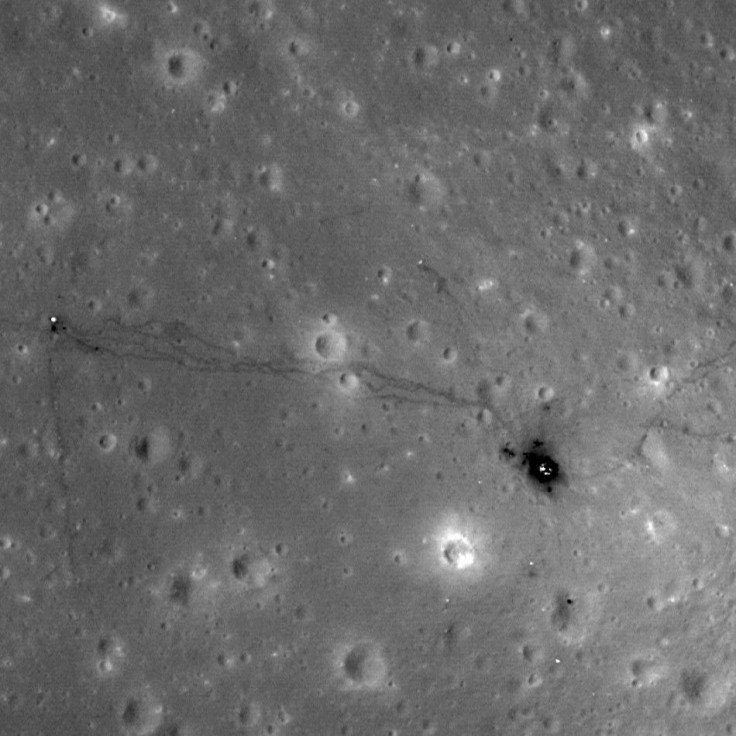Dark Side Of The Moon: Stunning New Pictures Released By China's Lunar Mission

New high-definition images of the far side of the Moon have been released by Chinese lunar missions Chang’e 4 lander and Yutu 2 rover.
Chinese Lunar Rover Yutu-2 Captures Stunning Images On The Far Side Of The Moon https://t.co/HjjBiIptic pic.twitter.com/tX9nEnr1r7
— advocator (@advocatorca) April 25, 2019
The new photographs show the dusty moon terrain full of craters, trails made by the Yutu 2 rover after its departure from the Chang’e 4 lander and Yutu 2 rover’s cast shadow on the lunar surface. The data collected by the lander and rover will be analyzed, and scientists are expected to publish the result in the succeeding months.
See the far side of the moon like never before: China releases stunning new images: China's Chang’e 4 lander and Yutu 2 rover have captured new images on their successful mission to explore the far side of the moon as the duo looks to extend their study… https://t.co/Xhj18mTJyM pic.twitter.com/ks01TfBUCo
— RushReads (@RushReads) April 23, 2019
Currently, the Chang’e 4 and Yutu 2 rover are in hibernation which lasts for about two Earth weeks. The Chinese lunar mission to explore the far side of the lunar surface has gone overtime, lasting longer than expected.
Chang’e 4 landed in the 186-kilometer-wide (11 mile-wide) Von Kármán Crater in the Moon’s far side, near its south pole, on Jan. 3.
Chang'e 4 landed on Jan 2 on the far side of the moon. The six-wheeled rover, Yutu 2, has already put a fair bit of space between itself and the lander, trundling over near the rim of a small crater on the floor of Von Kármán. Credit: CNSA | @SPACEdotcom https://t.co/TfBlCgN9fT pic.twitter.com/UZynfZRT2l
— The SETI Institute (@SETIInstitute) January 5, 2019
The lunar mission aims to investigate the geological and chemical differences between the near and far sides of the Moon. Our natural satellite, the Moon, is tidally locked to the Earth, forcing only one side to permanently face the planet.
According to Gizmodo, the crater is believed to be composed of various chemical compounds, including thorium, iron oxide and titanium dioxide, which could provide clues about the origin of the lunar mantle.
#China's Yutu-2 rover captures incredible new images of the #Moon's far side. https://t.co/LvWTHL07jv #space #nasa #science #geek #geeky pic.twitter.com/m3onfnhpPu
— TechEBlog (@techeblog) April 24, 2019
The “dark side of the Moon,” another term for the far side of the Moon, does not refer to “dark” as in the absence of light. It is called “dark” because it is unknown as this area had never been seen until Chang’e 4.
Four lunar days and nights (29.5 Earth days) have passed since Chang’e 4 and Yutu 2 rover’s landing. According to Planetary Society, as of April 12, they are back to hibernation again in preparation for its fourth lunar night.
The mission was expected to last for three lunar days, according to Space.com. So this fourth lunar day is a bonus for the China National Space Administration (CNSA). If the lander and rover survive the fourth lunar night, a fifth lunar day (April 28) of exploration would be possible.
The lander and the rover of the Chang'e-4 probe switched to dormant mode for the lunar night on Fri, with the rover traveling an accumulated 178.9 meters on the far side of the moon. The rover Yutu-2, or Jade Rabbit-2, is expected to awaken again on April 28. pic.twitter.com/9tb8dBahGc
— People's Daily, China (@PDChina) April 12, 2019
As of today, Yutu 2 rover has traveled a total of 178.9 meters (587.9 feet), based on the Lunar Exploration and Space Program Center of CNSA, as relayed by Chinese outlet Xinhua. This beat the record of its predecessor, Yutu 1, which accomplished 114 meters traveled distance before it died out in February 2014.
For the span of the fourth lunar day, Yutu 2 rover drove 8 meters for three days, from March 29 to April 1.
The lander and the rover were put on hibernation again to prevent them from being destroyed by the blazing heat of the Sun. Yutu 2 then accomplished another 8 meters of exploration for four days, from April 8 to 12, before going back to sleep as the fifth lunar night of the mission set in.
“There was no initial indication as to why Yutu-2 had covered relatively little ground in day 4, but Chang’e-4 chief designer Sun Zezhou told an audience at Nanjing University of Aeronautics and Astronautics on 11 April that the rover had been carefully navigating the area in order to approach and analyze specimens with its visible and infrared spectrometer (VNIS), similar to activities it performed during day 3,” Andrew Jones from the Planetary Society said in a report.
CNSA officials reported that the lander and rover are still working as expected.
© Copyright IBTimes 2024. All rights reserved.





















